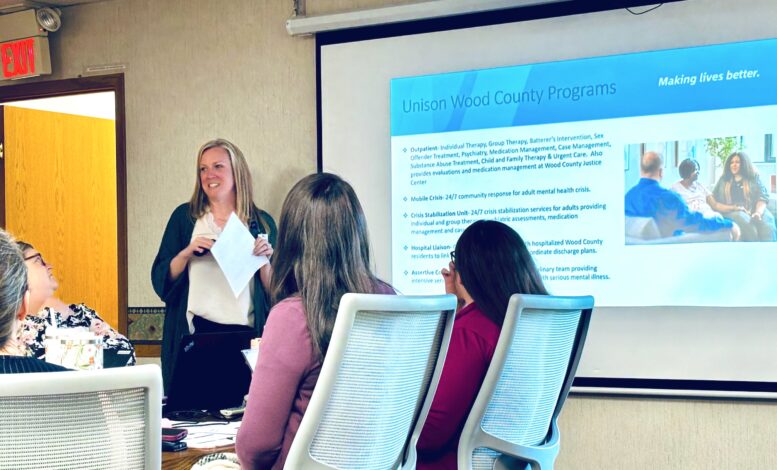By JULIE CARLE
BG Independent News
The uncertainties in funding for mental health and addiction services continues to at the forefront of conversations with the Wood County Alcohol, Drug Addiction and Mental Health Services Board.
At Monday’s board meeting, Katie Frank, director of Unison’s Wood County Services, said the biggest impact to their services from budget cuts will be their mobile crisis including a possible reduction in after-hours mobile crisis response, crisis flex funds, and the crisis peer position.
“We are proposing decreasing our after-hours mobile crisis response by seven hours,” she reported. “Typically, we’re on call 7 p.m. to 7 a.m. As part of our reduction plan, we are proposing going 7 p.m. to midnight only. So, from 12 a.m. until 7 a.m., we would not have mobile crisis response.”
They looked at the data based on call volume to determine the times that would be least impacted. The midnight to 7 a.m. time is used but not as often as other times of the day, she said.
The reduction of mobile response will likely increase the amount of time a person will wait for a response. “Our objective is to respond within an hour, and we do a pretty good job of that. I believe the reduction will impact that,” she said. Staff will come in at 7 a.m. to at least one person waiting, which will add wait time, or require staff to prioritize who needs to be seen first.
If the reduction of hours becomes a reality, “We will put a task on some of our community partners like the emergency rooms and our law enforcement partners,” she added.
That change could mean that law enforcement might take people directly to the hospital to be dropped off, where, if they are admitted to the emergency room and then released, the crisis team doesn’t know they were there, creating gaps around follow-up.
Additionally, the mobile crisis team handles the crisis screens after hours at the stabilization unit, “which means we won’t be able to admit anyone to the CSU between those hours,” she said. “We are going to have to triage as they walk in if they are able to wait for that assessment. Or if we can’t keep them safe, we may need to send them to the emergency room until our team is available to do that assessment.”
“This news concerns me quite a bit,” said Board President Frank McLaughlin. “How many consumers are not going to get served because of this?”
Based on the current fiscal year, Frank estimated it might impact 80 to 85 people during that midnight to 7 a.m. time, or between one and two people on average per week.
When asked if the reduced hours were because of finances or lack of use, Unison CFO Stacy Lawson, said the justification for the decrease in hours is financial. “We can bill Medicaid for some of the services, but it does not cover all the cost of the people required to run a 24/7 operation like this”
“This is a big deviation from what we were told would happen with this facility,” McLaughlin said. “Clearly, I know Unison and this board have made a substantial commitment to making these things work. This is a concern.”
“Some of this information is the first time we’re seeing it,” said WCADAMHS Executive Director Amanda Kern. “Us not being able to admit people in the middle of the night could become problematic for other contracts. We may have to go back to the drawing board and make sure we’re meeting both contracts.”
The Ohio Department of Mental Health and Addiction Services (OMHAS) “has been working with the (county) boards to improve our funding lines into six block grants” for areas such as mental health and crisis, said Kern. “The grants would give us some flexibility in what Wood County needs versus saying, ‘This is what Wood County needs, and this is how you spend those funds.’”
The state budget, which includes the OMHAS budget, is going through the legislature before it is finalized. The house version of the budget made reductions to criminal justice and substance use supports. The Senate, which just returned from break, will be acting on their version, which means “the state budget is pretty far from final,” Kern said.
Kern reported that WCADAMHS and Unison have been working on their budget concerns. Unison should have access to the OMHAS funding that is currently up in the air.
Regarding the out-of-county funds that will no longer come to the board directly, Kern said the county has options. The board can take over and manage the contracting piece with the out-of-county clients, or Unison can contract directly with the other boards, “which is a common practice for out-of-county clients,” she said. “That is still something we have to figure out.”
Frank said Unison has proposed reducing the crisis flex funds from the typical allocation of $50,000 to $15,000. These funds are often used for individuals in crisis who are released and need assistance with housing, medications, gas cards, groceries and utilities.
Eliminating Unison’s crisis peer position would provide a reduction of $24,000. Currently, the position offers one-to-one support to individuals in crisis by decreasing barriers to resources and encouraging them to continue their steps to recovery.
The crisis flex funds, Access to Wellness and the jail program will eventually “come out of those buckets of OMHAS dollars,” Kern said. “We are kind of shooting at a moving target and trying to figure out how much funding we will get and how much flexibility we will have in those block grants.”
The Wood County board plans to finalize allocations for the county service providers in May, before the start of the new fiscal year in July.





